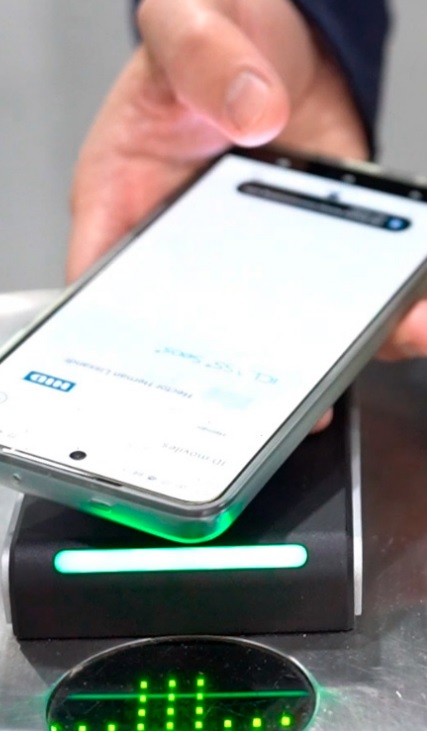Claro HID Mobile Access
Claro Selects HID Mobile Access® Solution to Manage a More Secure and Convenient Access for All Its Employees
Claro, part of the América Móvil Group, is a multinational telecommunications provider with a presence in the United States, Canada, and 13 Latin American countries. In Argentina, it is the leading integrated services telecom, having established itself as the company with the largest market share in the sector by providing coverage in over 550 locations, including both urban and rural areas. In addition to communication services, Claro offers enterprise products such as connectivity, cloud services, data center solutions, and Internet of Things (IoT) solutions, among others. In Argentina, Claro employs around 5,400 people across various fields, with its
main operations headquarters located in the capital, Buenos Aires.
CHALLENGE
With several offices located throughout the territory and thousands of employees within them, the issue of access control and the issuance of identification credentials over time presented a series of logistical complexities, leading to high costs and a significant amount of time for the company.
Using RFID proximity cards as access credentials for employees entailed a decentralized distribution and required multiple card printing points for personalization. The associated high cost from this process was another challenge — maintaining stock for producing new credentials, replacing cards due to loss or damage, among other complications, in addition to purchasing supplies. Amidst these challenges, we needed to bolster traceability and ensure heightened certainty regarding the utilization of credentials designated for Claro employees,” explained Héctor Hernán Lissandrello, Physical and Electronic Security Analyst at Claro.
A New System with HID Mobile Access, HID Signo and the Origo Platform
SOLUTION
So, the company carried out a significant upgrade to its access control system, incorporating HID Mobile Access technology for its new credentials. These credentials are remotely and centrally managed through the Origo platform, and the company transitioned from iClass readers to the iconic line of HID Signo readers.
HID Mobile Access solution allows the use of a mobile device as a credential to access doors, networks, services, and more. By leveraging Seos as the underlying technology, this approach notably enhances convenience and efficiency while maximizing security. Initially, Claro Argentina implemented around 800 Mobile Access licenses, a number expected to multiply in more upcoming renewal phases. During this transitional period, virtual credentials coexist with physical ones.
As far as the readers go, HID Signo access control readers provide reliable performance while upholding high-security standards and improved efficiency. In this specific scenario, the company implemented approximately 100 of these readers. Key attributes include versatility, as they are compatible with a broad array of credential technologies, including mobile access via Bluetooth® and NFC capability.
This upgrade was carried out across 50 common access points in corporate and technical buildings, where a significant number of employees are registered. “In terms of volume, we’ve covered approximately 40% of access points so far. Additionally, we anticipate extending this solution to other countries like Uruguay and Paraguay in the near future,” Lissandrello states.
RESULTS
By implementing HID Mobile Access, HID Signo readers, and the Origo platform, Claro Argentina successfully optimized its access control system while enhancing the credential management and administration. According to Lissandrello, thanks to the new technology, Claro was able to centrally manage credentials and avoid logistical issues, leading to reduced costs and saved time. The company also improved traceability and certainty in the employee’s proper credential usage. Because credentials are carried directly on their smartphones, loss or misuse of credentials were no longer an issue.
Lissandrello clarified that using HID Mobile Access credentials improved security and traceability. “Since employees have their credentials on their smartphones and often need to authenticate their ownership using methods
like PIN/pattern/fingerprint/facial recognition, the employee’s credential is used by the person themselves, reducing the risk of false identity.”
An additional benefit highlighted by the executive was the ability to digitize the entire credential assignment process. “This streamlined the entire process, from the moment an employee requests a credential to when they start using
it,” affirmed the analyst. With mobile credentials stored on smartphones, employees can access offices and other areas more efficiently and conveniently using a short-range gesture (tap) or an intuitive long-range gesture, “Twist & Go” (turn and enter). This also minimizes the risk of losing the credential since people are less likely to lend or misplace their phones.
Furthermore, migrating to a more secure technology like HID’s Seos involved adopting more advanced security measures and abandoning systems susceptible to cloning and. This includes the possibility of using multifactor
authentication that combines different methods on mobile devices to verify user identity.
The robust encryption of Seos secures data and protects confidential information. Now, Claro Argentina implements a centralized access management system to control permissions and record all activities, providing
stronger protection against unauthorized access and fostering greater security and confidence in the work environment.
Ultimately, the implementation and integration of the solution into the company’s access control platform was straightforward. “As end-users, HID provided us with the necessary support at all stages of implementation and
post-sales support.”

